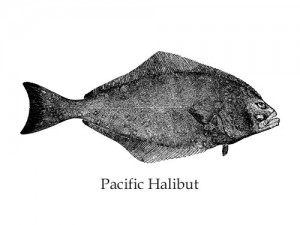 International Pacific Halibut Commission (IPHC) staff is recommending that all commercially landed Pacific halibut be required to be landed and weighed with the head attached for the landing record, according to a recent announcement.
International Pacific Halibut Commission (IPHC) staff is recommending that all commercially landed Pacific halibut be required to be landed and weighed with the head attached for the landing record, according to a recent announcement.
In 2013, the International Pacific Halibut Commission staff began a study to evaluate the relationships used to convert Pacific halibut length to weight, dressed weight to head-off weight, and the adjustment made for washed vs. unwashed weight. Collection of these data were integrated into all commercial catch sampling in 2015, as well as included in select survey operations during 2016.
Pacific halibut head weight removed during processing, as a percentage of the dressed body weight, has historically been assumed to be 10%; however, results from this study indicate that the average current head weight removed is around 12%, with a range from 9-18% among different ports and regulatory areas. The range comes from variations in where the head is cut off, and, to a lesser degree, in the proportion of the head to the body for smaller versus larger Pacific halibut.
Regulations for the commercial fisheries require the initial accurate scale weight of Pacific halibut at the time of offloading to be reported on the landing record (fish ticket – USA, validation record – Canada) with the delivery condition code.
Currently, when the fish ticket notes that the fish were weighed with the head on, reporting systems apply a 10% deduction for the weight of the head. Cutting larger heads than the assumed value, on average, and reporting weights after these cuts have management implications. This practice reduces the estimated net weight, potentially allowing more individual fish to be harvested within the catch limits.
Landing records show that, coastwide, 67-71% of catch by weight is reported head-off, so the potential effect of head proportions that differ from assumed values is large. For example, in recent years we may have underestimated the coastwide landings by 2-3%, with some individual regulatory areas more inaccurate than others.
In order to improve the accuracy of estimated landings, the Commission staff is recommending that all commercially landed Pacific halibut be required to be landed and weighed with the head attached for the landing record (fish ticket – USA, validation record – Canada).
Pacific halibut that are headed are not used to estimate removals in the sport or subsistence fisheries, so concerns about variation in head cuts do not apply to the data from those sectors.
The proposal will be available on the IPHC website and available for comment at the IPHC’s 2016 Interim Meeting and 2017 Annual Meeting.
The IHPC Pacific Halibut report can be found at: http://iphc.int/publications/rara/2015/RARA2015_09Lengthweight.pdf.
source: International Pacific Halibut Commission